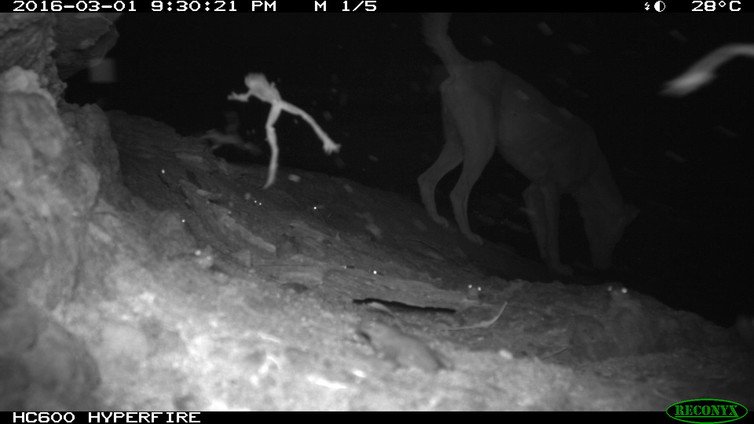The rise of citizen science is great news for our native wildlife

AUSTRALIA IS RENOWNED for its iconic wildlife. A bilby digging for food in the desert on a moonlit night, a dinosaur-like cassowary disappearing into the shadows of the rainforest, or a platypus diving for yabbies in a farm dam. But such images, though evocative, are rarely seen by most Australians.
As mammalogist Hedley Finlayson wrote in 1935:
The mammals of the area are so obscure in their ways of life and, except for a few species, so strictly nocturnal, as to be almost spectral.
For some species, our time to see them is rapidly running out. We know that unfortunately many native animals face considerable threats from habitat loss, introduced cats and foxes, and climate change, among others.
More than ever before, we need accurate and up-to-date information about where our wildlife persists and in what numbers, to help ensure their survival. But how do we achieve this in a place the sheer size of Australia, and with its often cryptic inhabitants?

How can we survey wildlife across Australia’s vast and remote landscapes? (Image credit: Euan Ritche)
Technology to the rescue
Fortunately, technology is coming to the rescue. Remotely triggered camera traps, for example, are revolutionising what scientists can learn about our furry, feathered, scaly, slippery and often elusive friends.
These motion-sensitive cameras can snap images of animals moving in the environment during both day and night. They enable researchers to keep an eye on their study sites 24 hours a day for months, or even years, at a time.
The only downside is that scientists can end up with millions of camera images to look at. Not all of these will even have an animal in the frame (plants moving in the wind can also trigger the cameras).
This is where everyday Australians can help: by becoming citizen scientists. In the age of citizen science, increasing numbers of the public are generously giving their time to help scientists process these often enormous datasets and, in doing so, becoming scientists themselves.

A camera trap records a leaping frog while a dingo takes a drink at the waterhole in the background. (Image credit: Jenny Davis)
What is citizen science?
Simply defined, citizen science is members of the public contributing to the collection and/or analysis of information for scientific purposes.
But, at its best, it’s much more than that: citizen science can empower individuals and communities, demystify science and create wonderful education opportunities. Examples of successful citizen science projects include Snapshot Serengeti, Birds in Backyards, School Of Ants, Redmap (which counts Australian sealife), DigiVol (analysing museum data) and Melbourne Water’s frog census.
Through the public’s efforts, we’ve learnt much more about the state of Africa’s mammals in the Serengeti, what types of ants and birds we share our cities and towns with, changes to the distribution of marine species, and the health of our waterways and their croaking inhabitants.
In a world where there is so much doom and gloom about the state of our environment, these projects are genuinely inspiring. Citizen science is helping science and conservation, reconnecting people with nature and sparking imaginations and passions in the process.
Australian wildlife in the spotlight
A fantastic example of this is Wildlife Spotter, which launched 1 August as part of National Science Week.
Researchers are asking for the public’s help to identify animals in over one million camera trap images. These images come from six regions (Tasmanian nature reserves, far north Queensland, south central Victoria, Northern Territory arid zone, and New South Wales coastal forests and mallee lands). Whether using their device on the couch, tram or at the pub, citizen scientists can transport themselves to remote Australian locations and help identify bettongs, devils, dingoes, quolls, bandicoots and more along the way.

A Torresian Crow decides what to do with a recently shed snake skin. (Image credit: Jenny Davis)
By building up a detailed picture of what animals are living in the wild and our cities, and in what numbers, Wildlife Spotter will help answer important questions including:
-
How many endangered bettongs are left?
-
How well do native predators like quolls and devils compete with cats for food?
-
Just how common are common wombats?
-
How do endangered southern brown bandicoots manage to survive on Melbourne’s urban fringe in the presence of introduced foxes, cats and rats?
-
What animals visit desert waterholes in Watarrka National Park (Kings Canyon)?
-
What predators are raiding the nests of the mighty mound-building malleefowl?

An endangered southern brown bandicoot forages in vegetation on the outskirts of Melbourne. (Image credit: Sarah Maclagan)
So, if you’ve got a few minutes to spare, love Australian wildlife and are keen to get involved with some important conservation-based science, why not check out Wildlife Spotter? Already, more than 22,000 people have identified over 650,000 individual animals. You too could join in the spotting and help protect our precious native wildlife.
![]()
Euan Ritchie, Senior Lecturer in Ecology, Centre for Integrative Ecology, School of Life & Environmental Sciences, Deakin University; Jenny Davis, Head of School, School of Environment, Charles Darwin University; Jenny Martin, Lecturer in Science Communication, School of Biosciences, University of Melbourne, and Sarah Maclagan, PhD candidate, Centre for Integrative Ecology, Deakin University
This article was originally published on The Conversation. Read the original article.
READ MORE:
- Researchers need you to collect feathers
- Citizen scientists help shark conservation
- Citizen science: using the power of the masses
- Dingo declared a separate species




